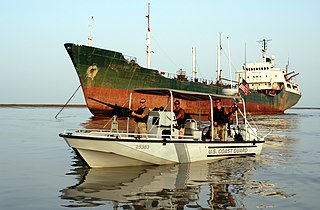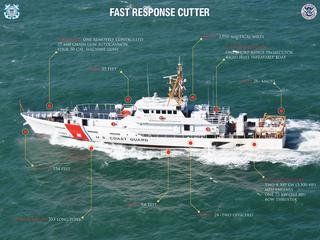
The United States Coast Guard (USCG) is the maritime security, search and rescue, and law enforcement service branch of the United States Armed Forces and one of the country's eight uniformed services. The service is a maritime, military, multi-mission service unique among the United States military branches for having a maritime law enforcement mission with jurisdiction in both domestic and international waters and a federal regulatory agency mission as part of its duties. It is the largest and most powerful coast guard in the world, rivaling the capabilities and size of most navies.

The United States Coast Guard Auxiliary is the civilian uniformed volunteer component of the United States Coast Guard. Congress established the unit on 23 June 1939, as the United States Coast Guard Reserve. On 19 February 1941, the organization was re-designated as the United States Coast Guard Auxiliary. The Auxiliary exists to support all USCG missions on the water or in the air, except for roles that require "direct" law enforcement or military engagement. As of 2022, there were approximately 21,000 members of the U.S. Coast Guard Auxiliary.

The United States Coast Guard commissioned a new Keeper class of coastal buoy tenders in the 1990s that are 175 feet in length and named after lighthouse keepers.

The Long Range Interceptor (LRI) is an 11-meter high speed launch vessel designed to be deployed from United States Coast Guard cutters via a rear launching ramp. The Long Range Interceptor is an aluminum boat, powered by Ultrajet brand water-jets, for intercepting and boarding suspect vessels. It mounts a radar, special shock-proof seats, and can travel at 35 knots (65 km/h). They can be armed with machine guns or grenade launchers, and can be equipped with ballistic panels for crew protection when required.

The Japan Coast Guard is the coast guard of Japan.

United States Coast Guard Port Security Units are deployable specialized units organized for sustained force protection operations. They can deploy within 96 hours and establish operations within 24 hours of arrival. PSUs conduct OCONUS port security in support of requesting regional Combatant commander. They provide Anti-Terrorism and Force Protection missions which include harbor and port defense, Humanitarian aid, coastal surveillance, and special missions. PSUs usually operate in U.S. territorial waters under the direction of the Coast Guard's command, but can quickly be called upon the Department of Defense request.

The Sentinel-class cutter, also known as Fast Response Cutter due to its program name, is part of the United States Coast Guard's Deepwater program. At 154 feet (46.8 m) it is similar to, but larger than the 123-foot (37 m) lengthened 1980s-era Island-class patrol boats that it replaces. Up to 58 vessels are to be built by the Louisiana-based firm Bollinger Shipyards, using a design from the Netherlands-based Damen Group, with the Sentinel design based on the company's Damen Stan 4708 patrol vessel. The Department of Homeland Security's budget proposal to Congress, for the Coast Guard, for 2021, stated that, in addition to 58 vessels to serve the Continental US, they requested an additional six vessels for its portion of Patrol Forces South West Asia.

The Defender-class boat, also called Response Boat–Small (RB-S) and Response Boat–Homeland Security (RB-HS), is a standard boat introduced by the United States Coast Guard in 2002. The boats serve a variety of missions, including search and rescue, port security and law enforcement duties and replaces a variety of smaller non-standard boats.

USCGC Spar (WLB-206) is a United States Coast Guard Juniper-Class seagoing buoy tender home-ported in Duluth, Minnesota. The ship maintains aids to navigation in the Twin Ports and Great Lakes.
This article covers the organization of the United States Coast Guard.

The Joint Maritime Training Center (JMTC), also known as the Special Missions Training Center (SMTC), is a joint United States Coast Guard, Navy, and Marine Corps training facility located on Camp Lejeune, North Carolina. JMTC's mission is to provide relevant and credible Maritime Security Training and Operational Testing and Evaluation in support of Department of Defense and Department of Homeland Security missions. JMTC comprises four main divisions: Weapons, Port Security, Engineering / Logistics, and Fast Boat.
A Sector is a shore-based operational unit of the United States Coast Guard. Each Sector is responsible for the execution of all Coast Guard missions within its Area of Responsibility (AOR), with operational support from Coast Guard Cutters and Air Stations. Subordinate commands within a Sector typically include Stations and Aids-to-Navigation (ATON) Teams. Some Sector commands also have subordinate units such as Sector Field Offices and Marine Safety Units that are responsible for mission execution in parts of the Sector's AOR. There are 37 sectors within the Coast Guard.

The Heritage-class cutter, also known as the Offshore Patrol Cutter and the Maritime Security Cutter, Medium, is a cutter class of the United States Coast Guard (USCG), developed as part of the Integrated Deepwater System Program and built by Eastern Shipbuilding and Austal USA. Construction of the first vessel in the class began in January 2019. As they are completed, it is expected that they will replace 270-foot (82 m) Famous- and 210-foot (64 m) Reliance-class Medium Endurance Cutters.

The Legend-class cutter, also known as the National Security Cutter (NSC) and Maritime Security Cutter, Large, is the largest active patrol cutter class of the United States Coast Guard. Entering into service in 2008, the Legend-class is the largest of several new cutter designs developed as part of the Integrated Deepwater System Program.

The Helicopter Interdiction Tactical Squadron (HITRON) is an armed United States Coast Guard helicopter squadron specializing in Airborne Use of Force (AUF) and drug-interdiction missions. It is based at Cecil Field in Jacksonville, Florida.

The Cutter Boat – Over the Horizon (CB-OTH), is a cutter-deployed rigid-hulled inflatable boat in service with the United States Coast Guard. It is designed to pursue and interdict fast, non-compliant vessels. As of 1 March 2018, 78 boats have been delivered, and deployed on a variety of cutters, including the Maritime Security Cutters, Hamilton-class High Endurance Cutters, and Famous and Reliance-class Medium Endurance Cutters, and the Sentinel-class cutters. Eventually, at least 101 boats will be deployed.

Patrol Forces Southwest Asia (PATFORSWA) is a United States Coast Guard command based in Manama, Bahrain. PATFORSWA was created in November 2002 as a contingency operation to support the U.S. Navy with patrol boats. The command's mission is to train, equip, deploy and support combat-ready Coast Guard forces conducting operations in support of Operation Iraqi Freedom (OIF), Operation Enduring Freedom (OEF) and Operation Inherent Resolve (OIR) in the Naval Forces Central Command's area of responsibility. It was commissioned as a permanent duty station in June 2004. In July 2003 PATFORSWA moved from its own compound to facilities at Naval Support Activity Bahrain.

USCGC Margaret Norvell (WPC-1105) is the fifth Sentinel-class cutter , based at Miami, Florida after commissioning. She was launched on January 13, 2012, and delivered to the Coast Guard on March 21, 2013. She was commissioned on June 1, 2013. She was commissioned at Mardi Gras World in New Orleans, near where her namesake staffed her lighthouse for decades.

The 32-foot Transportable Port Security Boat (TPSB) or , normally operated by United States Coast Guard Port Security Units (PSUs), provides for defense readiness operations in the United States and when PSUs are deployed overseas. It travels at 43-plus knots, and carries up to two .50 caliber M2 Machine Guns and two 7.62mm M240G Machine Guns. There are 52 in operation.

















